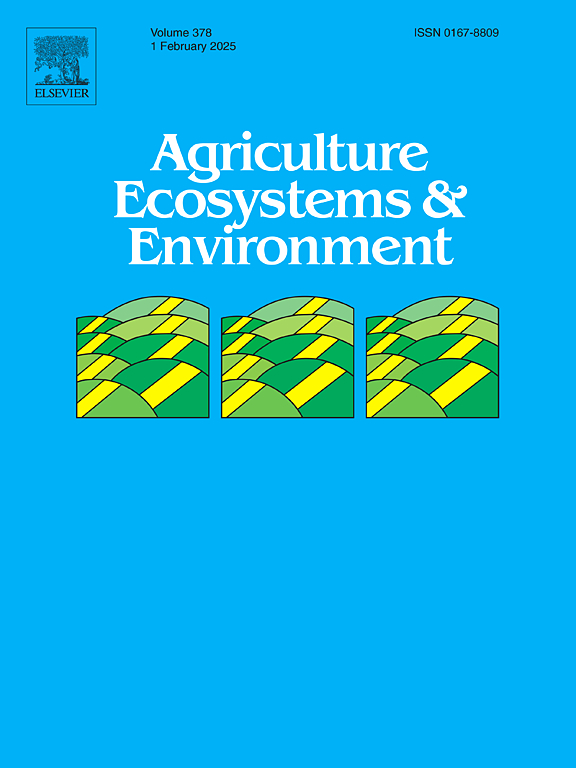草地温室气体排放对不同人类干扰的响应--全球元分析
IF 6
1区 农林科学
Q1 AGRICULTURE, MULTIDISCIPLINARY
引用次数: 0
摘要
人类活动增加了草原的温室气体排放,加剧了全球变暖。然而,草原温室气体(二氧化碳、一氧化二氮和甲烷)在不同气候区对人类干扰的反应,以及温室气体排放与气温和降水之间错综复杂的关系,都需要进一步阐明。一项关于过去 40 年人类干扰对草地温室气体影响的 Meta 分析显示,放牧、施肥、除草和焚烧对草地的 N2O、CH4、CO2 和温室气体排放总量有显著影响。然而,轻度和中度放牧对二氧化碳排放通量没有实质性影响。在寒带草原,放牧对 N2O 排放通量的影响最大,施肥对 CH4 排放通量的影响高于放牧,而 CO2 排放通量对重度放牧的敏感性高于重度施肥。在温带草原和热带稀树草原,温室气体排放通量对施肥最为敏感,热带稀树草原的二氧化碳排放通量对焚烧尤其敏感。温度和降水的增加对施肥草地 CO2e 的影响大约是放牧草地的两倍,是刈割草地的四倍。这项研究强调了人为干扰对草地温室气体排放的更大影响,尤其是施肥干扰对大多数草地地区温室气体排放的影响最为显著。在草地管理过程中降低施肥水平是减少草地温室气体排放的关键一步。总之,严格控制干扰强度是减少温室气体排放的有效策略,尽管可能会影响草原生产力。未来的工作重点应该是确定最佳干扰强度,以便在这些复杂的影响中取得平衡。本文章由计算机程序翻译,如有差异,请以英文原文为准。
Response of grassland greenhouse gas emissions to different human disturbances – A global Meta-analysis
Human disturbances have increased greenhouse gas (GHG) emissions from grassland, worsening global warming. However, the response of grassland GHG (CO2, N2O, and CH4) to human disturbances across various climatic zones requires further elucidation, as does the intricate relationship between GHG emissions and temperature and precipitation. A Meta-analysis of the effects of human disturbances on GHG in grassland over the past 40 years revealed that grazing, fertilization, mowing, and burning significantly influenced the total emissions of N2O, CH4, CO2, and GHG from grassland. However, the light and moderate grazing exerted no substantial impact on CO2 emission flux. In frigid zone grassland, the N2O emission flux was most significantly affected by grazing, the CH4 emission flux affected by fertilization was higher than grazing, and the CO2 emission flux was more sensitive to heavy grazing than severe fertilization. In temperate grassland and savanna, GHG emission flux was most sensitive to fertilization, with CO2 emission flux in savanna being particularly responsive to burning. The effect of increased temperature and precipitation on CO2e in fertilized grassland was approximately double that of grazed grassland and quadruple that of mowed grassland. This study emphasizes the increased effect of human disturbances on GHG emissions in the grassland, especially with the most significant impact of fertilization disturbances on GHG emissions in most grassland areas. Lowering the level of fertilization during grassland management could serve as a crucial step in mitigating GHG emissions from grassland. In summary, rigorous control of disturbance intensity represented an effective strategy for mitigating greenhouse gas emissions, albeit potentially impacting grassland productivity. Future endeavors should focus on determining the optimal disturbance intensity to strike a balance amidst these complex effects.
求助全文
通过发布文献求助,成功后即可免费获取论文全文。
去求助
来源期刊

Agriculture, Ecosystems & Environment
环境科学-环境科学
CiteScore
11.70
自引率
9.10%
发文量
392
审稿时长
26 days
期刊介绍:
Agriculture, Ecosystems and Environment publishes scientific articles dealing with the interface between agroecosystems and the natural environment, specifically how agriculture influences the environment and how changes in that environment impact agroecosystems. Preference is given to papers from experimental and observational research at the field, system or landscape level, from studies that enhance our understanding of processes using data-based biophysical modelling, and papers that bridge scientific disciplines and integrate knowledge. All papers should be placed in an international or wide comparative context.
 求助内容:
求助内容: 应助结果提醒方式:
应助结果提醒方式:


